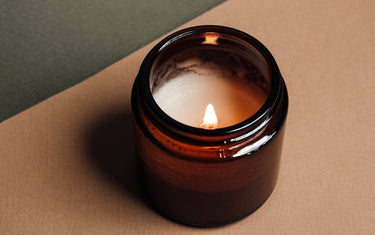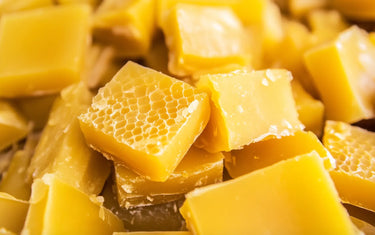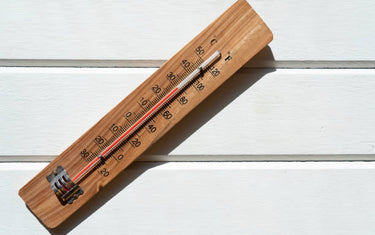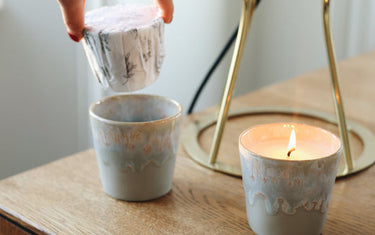7 min read / 25 January 2024 / yasmin sharp
How to Get Wax Out of Candle Jars
Discover effective techniques to safely remove wax from candle jars and give them a new purpose, providing you with practical tips on revitalising your favorite candle containers.
Share this post

What can I do with leftover candle wax?
Can I clean candle jars using boiling water?
Can I clean candle jars in the freezer?
Can I clean candle jars in the oven?
Can I clean candle jars with a microwave?
Can I clean candle jars with a hairdryer?
Understanding how to get wax out of candle jars and containers gives you even more ways to recycle and repurpose it to make something new and useful for your home.
When there is about ½ inch of wax remaining in a candle jar it is usually time to stop using it, as continuing to light the wick could damage the container or the surface below.
Getting wax out of candle jars shouldn’t have to be a stressful experience, and we explain how by suggesting a few methods that can save you a lot of time and effort.
Why should I reuse wax?Before we explain how to get wax out of candle jars, it’s helpful to know why you are doing it in the first place. Some of the main reasons for reusing melted wax include:
|

What can I do with leftover candle wax?
Now you know the benefits of recycling old wax, it’s also good to understand what you can do with it.
Here are some ideas:
- New candles: if you collect enough old wax you may have enough to melt it all down to restart the candle making process. You could make one or two larger candles or simply a batch of smaller tealights.
- Wax melts: Old fragranced wax can be put to use as wax melts, allowing you to enjoy the aroma for longer. These are usually quite small in size, so you may be able to make quite a few to enjoy.
- Seal envelopes: This can be the perfect finishing touch for birthday and seasonal cards, making the recipient feel even more special as they open a personalised envelope.
- Light up garden fires: Recycled wax can be used as scented fire starters, simply by placing them under wood and kindling to get things going. This is a great idea if you have a firepit and love to entertain during the spring and summer.
- Fragrance pouches: If you can’t get enough of the old candle fragrance, you could turn the old wax into a fragrance pouch. These are ideal for clothing drawers, cars and closets, helping you to freshen things up a little.
For anyone who has not recycled or repurposed candle wax before, why not take a look at our guide on how to make candles from old candles, which breaks the process down into manageable steps?
Can I clean candle jars using boiling water?
If you want to learn how to get wax out of candle jars using boiling water, follow the steps below:
- Add boiling water: Boil enough water to fill the candle jar and carefully pour inside, leaving about an inch of space at the top to avoid spillages and burns. You can then leave the water to settle for a while, giving it time to melt the wax. As the wax is removed from the side of the container it should start to float to the top.
- Remove the wax: Before removing the wax from the water, ensure that the water has cooled so it is safe to touch. An easy way to do this is to block the drain and strain out the water so you can scoop out the wax. It’s a substance that can quite easily clog up drains, so take time to ensure you have cleared up as much as possible.
- Soak the jar: Another method you could try is to soak the jar in warm water, which will heat the container and loosen the wax. To do this, fill the sink or a large enough pan with warm water and place the candle container inside. One thing to bear in mind is that this method will also remove any labels or any other decorations on the outside of the container, so if you want them to remain, you may not want to use this method.

Can I clean candle jars in the freezer?
You can also use colder temperatures to get wax out of candle jars.
Try the following to see if it works for you:
- Leave the candle jar in the freezer overnight.
- Take the jar out in the morning and turn it over – the wax should be fully frozen and ready to fall out in one lump.
- You may need to give the bottom of the jar a few taps or use a spoon or butter knife to carefully wedge it out.
The logic behind this method is that cold temperatures help to shrink the wax, potentially making it much easier to remove it without too much hassle.
Can I clean candle jars in the oven?
Hot and cold temperatures are simple but effective tools you can use to remove wax, which also means you could use the oven.
However, if are using a candle glass jar that features glitter, sequins or similar decorations, you should use another method:
Follow the steps below:
- Prepare the oven: Use aluminium foil to line a baking sheet before placing it in the oven. Then place the candle jar(s) upside down on the tray.
- Warm the oven: Turn the oven to 100 degrees Celsius and after 15 minutes the wax should start to melt and pool on the foil. Turn off the oven and then use oven gloves to remove the sheet and then the jar(s).
- Clean the jar: Once the jar has cooled and is safe to touch, you can clean it using warm water and soap. Let the wax cool and harden on the foil, after which you can either reuse it or discard.

Can I clean candle jars with a microwave?
So, if an oven works, can you use a microwave to get wax out of candle jars? The answer is also yes, and the method couldn’t be easier.
Try the following to see for yourself:
- Fill the candle container with water and place it into the microwave.
- Turn on the microwave on a medium heat for about 90-120 seconds.
- The wax should melt and rise to the top of the water.
- When the glass and wax have cooled, use a butter knife or spoon to remove the remaining wax.
If the wick of the candle has a metal wick holder then you should use an alternative method, as this could pose a fire hazard.
Can I clean candle jars with a hairdryer?
Another heat option you could use to remove the wax from a candle jar is with a hairdryer.
Many people use this method to remove wax from carpets, as it makes the process much easier.
Try the following:
- Turn the hairdryer to a warm (but not too hot) setting.
- Heat the sides and bottom of the jar with the hairdryer.
- After a short while the wax should be softened enough so it can be removed with a butter knife or spoon.
Keep a close eye on the temperature of the container during the melting stage, as it can cause damage or cracks to some plastic or glass jar holder.
How do I clean a candle jar?
You’ll probably want to clean the candle jar after you have removed the wax as there will likely be bits of residue and soot left on the glass.
To clean the jar, all you’ll need is a sponge and some water and soap, so you can remove any dirt that has remained.
You may find that some older candles have stubborn build up, so a bottle brush could work or an adhesive removal could do the trick.

Hopefully our guide on how to get wax out of candle jars has given you plenty of food for thought, so you can reuse any old wax you have lying around.
There are plenty of ways you can repurpose old wax too, whether it’s to make new candles or wax melts, or as a garden fire starter or to make refreshing fragrance pouches.
It can help save you money and is good for the environment and because the process is relatively straightforward, it shouldn’t take up too much of your time.









